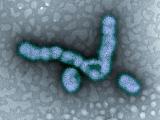The US Department of Health and Human Services (HHS) has spent $440 million in the past 2 years on contracts to strengthen the manufacturing base for defenses against pandemic flu and other public health threats, but it's too early to tell how well the efforts will pay off, according to a Government Accountability Office (GAO) report released yesterday.
The report focuses on HHS's move to develop flexible manufacturing facilities to support the development of medical countermeasures against pandemic flu and other chemical, biological, radiological, and nuclear (CBRN) threats. The effort stems from a reevaluation of US medical countermeasures activities in 2010, following the 2009 flu pandemic, when most of the pandemic flu vaccine supply arrived after the epidemic's peak.
One conclusion of the 2010 review, the GAO notes, was that HHS should establish "Centers for Innovation in Advance Development and Manufacturing" (CIADMs) and related facilities to support the production and distribution of countermeasures.
Contracts for capacity, distribution
In fiscal years 2012 and 2013, HHS's Biomedical Advanced Research and Development Authority (BARDA) awarded contracts totaling about $400 million for three CIADMs. The contracts went to Emergent Manufacturing Operations, Baltimore; Novartis Vaccines and Diagnostics, Cambridge, Mass.; and Texas A&M University, College Station, Tex.
The GAO says the contracts require the organizations to do three things: develop the capacity to make pandemic flu vaccines in an emergency (up to 50 million doses in 4 months), establish "core services" to support the development of CBRN countermeasures generally, and provide workforce training.
BARDA also awarded a total of $40 million to four companies to set up packaging facilities to prepare countermeasures for distribution. The four companies in the "Fill Finish Manufacturing Network" are Cook Pharmica, Bloomington, Ind.; DSM Pharmaceuticals, Greenville, N.C.; JHP Pharmaceuticals, Parsippany, N.J.; and Nanotherapeutics, Alachua, Fla., which is partnering with Baxter Pharmaceutical Solutions.
The network's main purpose is to provide fill-finish services for pandemic flu vaccines, but it also could provide such services for certain aseptic drugs during a shortage, the report says. The companies are expected to be equipped to fill and finish 117 million doses of pandemic flu vaccine in 12 weeks.
The three CIADMs are scheduled to complete construction or retrofitting of facilities, acquire a pandemic flu vaccine candidate, and validate their manufacturing surge capacity with the FDA by the end of their contract base period, the GAO says. That means 2020 for Emergent, 2016 for Novartis, and 2017 for Texas A&M.
BARDA officials told the GAO that they expect at least one CIADM will be ready to start making pandemic flu vaccine in 2017 and that all three will be ready by 2020.
Too early to assess HHS approach
The GAO found that HHS followed the recommendation from the 2010 review to establish CIADMs capable of providing core services to support the production of CBRN countermeasures. "However, it is too early to tell how effective this approach will be because HHS has not begun to issue task orders to CIADMs for core services," the report states.
It adds that BARDA has set up a CIADM steering committee and written guidance to govern the task order process once the CIADMs are operating.
"BARDA officials said that they anticipate having sufficient demand for the services and funding for task orders in fiscal years 2014 and 2015," the report says.
HHS officials agreed with the GAO's conclusions, the report says. The officials also commented that the CIADMs are almost a year ahead of schedule in completing production and stepping up activities in anticipation of receiving the first HHS task orders this year.
An appendix to the report lists 24 types of core services the CIADMs are expected to provide. Some examples are regulatory affairs support, quality control support, clinical and nonclinical studies, pilot manufacturing of clinical investigation lots, and process validation.
See also:
Mar 31 GAO report summary
Full GAO report (36 pages)





















